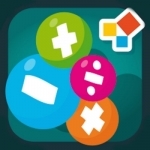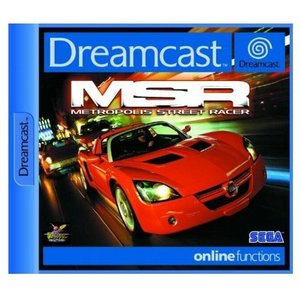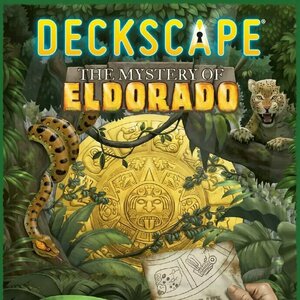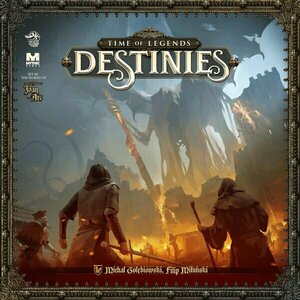Purple Phoenix Games (2266 KP) rated Deckscape: The Mystery of Eldorado in Tabletop Games
Mar 12, 2021
Imagine yourself trapped on a jungle island after your plane crashes. Or being locked within a pyramid whilst visiting Egypt. These are the settings for the pair of games we reviewed and I really cannot and will not be going further into a lot of detail so as to avoid any spoilers as best I can.
DISCLAIMER: We were provided a copy of both The Curse of the Sphinx and The Mystery of Eldorado for the purposes of this review. These are retail copies of the games, so what you see in these photos is exactly what would be received in your boxes. I will describe the overall game flow and major rule set so that our readers may get a sense of how the game plays. For more info, you may purchase a copy online or from your FLGS. -T
To setup a game of Deckscape, open the box and take out the cards. You are now ready to play. Seriously. No rules to read. Nothing to teach others. Just read the top card and do as it says. You have now begun your adventure!
Playing the games involves players (or a solo player) encountering cards in the 60-card deck in order to solve puzzles and use items found to best finish the scenario. There are no turns in these games, and players are encouraged to discuss possibilities before committing to answers to the puzzles. Randy from Dora and the Lost City of Gold would be so happy to be figuring out “Jungle Puzzles” and “Pyramid Puzzles.”
Each card is either a puzzle or an item and each card will more than likely be encountered throughout the game. Players are trying to figure out the puzzle clues and best solve them. Incorrect guesses will result in costly errors that affect endgame scoring. Sometimes correct guesses will allow the players to erase errors or give other positive clues.
Once the players have made their way through the game solving puzzles and riddles they will consult the table at the end to see how well they scored. Usually time is of the essence, and finishing the games sooner is better than later. Once the game is over and the score tallied the game owner may gift the game away as the final result is known and replaying is kinda cheating.
Components. Okay, these games are small boxes full of large cards. There are 60 cards in each game and the cards are beautifully illustrated and laid out well. We had no problems reading anything or deciphering any part of the games, so thumbs up on components from us.
Gameplay is a little polarizing, we found. I like the flow of the game and puzzles within. My wife, however, couldn’t stand them. But she later admitted to now understanding that she just does not enjoy escape room styled board and card games. That said, these games play more like Choose Your Own Adventure games than the typical EXIT/Unlock style games, as most (if not all) cards in Deckscape require players to complete them before moving to the next card in numerical order with either a success or penalty. This can rub players the wrong way if they are used to the other style of escape room games. It was no problem for me, and I enjoyed my plays.
What I liked most about these games is that the story is easy to follow and the puzzles mostly make logical sense. A few of them stumped me, but luckily players may find helper cards to give clues to puzzles in the game. We relied on these helpers a few times, but I did not feel like we were consulting them for every puzzle. So that’s a definite positive. I also liked the thematic immersion. For a card game I felt drawn into the stories and wanted to complete them as well as I could.
What I disliked most about these games is the fact that you end up encountering every card or nearly every card. The intrigue of other escape room games I have played is wondering what was on some of those other cards. Or what did I miss on a card that I should have noticed? While you get SOME of that here, I found Deckscape to be more entry-level in difficulty. That is certainly not a bad thing for most gamers. We were expecting something different than what we played, and I think that unfortunately immediately put us off at first.
However, I played the second game solo and I liked it quite a bit. I think I mostly liked it because I didn’t have my wife around to figure out the puzzles with me and I was truly all alone. This added to my anxiety to finish well, or finish at all! I definitely cannot see myself playing these games with the full compliment of six players as I feel I would be too overwhelmed with people shouting out their guesses and trying to parse everything. But that’s just me. I prefer these with low player counts.
All in all these games are pretty good, and a decent something different from the other games in the same style. If you have yet to try Deckscape and like escape room games in general, I reccomend you give them a try. They are quick (and even quicker as your goal is finish in a short amount of time for the best scores), easy to play with zero teaching and setup time, and gives a great amount of puzzles to decipher. Purple Phoenix Games gives the Deckscape system of games an unsure-but-you-seem-confident-about-your-answer-so-let’s-just-go-with-yours 6 / 12. If you see them on the shelves pick one up and try it out. Add these to your growing collection of escape room games for show, or play them and pass them along, as I intend to do.
(Note: I usually add a messy components photo at the end of my reviews, but I don’t want to spoil anything, so I’ll just throw some cards down that won’t really ruin anything at all.)
Purple Phoenix Games (2266 KP) rated Chronicles of Crime: 2400 in Tabletop Games
Nov 17, 2021
Chronicles of Crime: 2400 (which I shall shorten to 2400 for the duration of this preview) is an app-assisted campaign, murder-infested, cooperative storytelling game for one to four players. If you are familiar with the original Chronicles of Crime, you already mostly know how to play 2400 (there are a few new mechanics here). However, should ye be of the uninitiated, allow me to set the stage for this incredible gaming experience.
DISCLAIMER: We were provided an advance retail copy of this game for the purposes of this preview. These are retail copy components, so they should be exactly what you would receive in your copy. Also, it is not my intention to detail every rule in the game, as there are just too many. You are invited to download the rulebook, purchase directly from the publisher, or through any retailers stocking it after fulfillment. -T
To setup, place the Evidence Board in the middle of the table and the Home Location Board near. Keep all the decks of cards nearby (shuffled or unshuffled, whatever is your liking) as well as the alphabetically-labeled, double-sided Location Boards. Place out the Implant Board and the Raven card within reach (new to 2400). Fire up the Chronicles of Crime app, choose “2400,” and then choose the case you would like to play. The app will walk players through the additional setup steps for the case being played. For this solo preview the photos represent happenings in the Tutorial scenario. Also, to be completely upfront I got a perfect 100/100 for a final score… for the introductory Tutorial. Autographs can be purchased at the end of the preview.
Each of the cases will involve players traveling to different Location Boards and meeting Characters at these locations. Many cases will be involving several Special Items and, new for the 2400 version, augments to the main character, Kalia Lavel, and her cybernetically-enhanced pet Raven. The Raven (unnamed in the game) acts as a portable computer, able to access information across the web and provide insight into certain aspects of the case being solved.
By using the app and scanning the QR codes on the boards and cards players will be learning about the case, viewing the scene of the crime(s), inspecting items, chatting up locals for information, and also new for 2400: visiting new Cyberspace Locations (a la The Oasis in Ready Player One)! With so many new additions to the CoC series here in the 2400 chapter, seasoned vets will find something for which they can be excited.
Play will continue not so much in “rounds” but until the players have enough evidence and a good handle on the situation enough to return Home to recharge, or visiting HQ to divulge case information by scanning answers to their questions about the case. The app then assesses the accuracy of the answers and outputs a score. For reference, though I did receive 100/100 on my first play of 2400 I did only receive a 70/100 on my first runthrough of the original Chronicles of Crime, so playing this style of game several times seems to improve how one plays.
Components. As most items in the box of the game are card or cardboard-based, and all really great quality, I will speak on other component items. Firstly, the art and art style throughout the game is simply stunning. I mean look at those Location cards and character art! This art really speaks to me and it says, “I’m gorgeous.” As a side note, I think I will be contacting Lucky Duck Games to get my hands on the font used on the Evidence Category cards. It’s just a perfect choice in this setting.
The app. I have only great things to say about the app. It’s the same app that you would use for all Chronicles of Crime games, and operates the exact same way. For me it has been flawless to use and just a joy to bring technology into the gaming world, especially for a game set in the year 2400. I am obviously no purist game enthusiast, as I enjoy these hybrid model games. Once you play with the app you will see how ingenious a system it really is. The app coupled with the nondescript cards and other components in the game make for infinite storytelling possibilities that can only be limited by creativity and time constraints. I love the components in the box AND the marvelous app.
Gameplay for me is also just glorious. I love being able to sit down, setup the game, and let the app tell me what’s going on. So what should I do first? Oh, let’s mosey on down here to this Location Board and drum up some information. Ooh I found an Item! I should have the Raven scan it for any historical information. Hmm, it registers as being hot? Okay, time to go back to that location and speak with the other person who was in there. OH CRAP, I wasted too much (in game) time and now that other person is gone?! Uh oh, I better stop messing around here…
It’s just amazing, and I love this family of games. I am so stoked to delve more into 2400 and discover more shenanigans happening in futuristic Paris. My implants (no jokes here please), Raven, and I are out to solve all the cases and beg for more. If you are looking for a game that uses a hybrid board game/app model, are a fan of this setting, or just want to have a really great experience playing a game, I urge you to consider Chronicles of Crime: 2400. It has everything I love in a unique game and I just can’t get enough! Oh, and for me, this is the best one of the bunch. I don’t know what it is exactly that I love so much, but it adds the right amount of extra stuff to CoC that I just feel like playing these scenarios endlessly. That is, until I have run out of scenarios and have to cry to LDG or fans to create more and more. If only I were more creative.
Purple Phoenix Games (2266 KP) rated Destinies in Tabletop Games
Jan 29, 2022
Destinies is a hybrid app-driven adventure board game for one to three players. In it, players will be choosing their characters and how to play them, along with the path of their individual destinies across several campaign scenarios. When playing multiplayer, the player who completes their destiny first will win. When playing solo (which is also amazing), the player wins when they successfully complete their destiny.
DISCLAIMER: We are using the Kickstarter version of the game. We do have the expansions from the KS campaign, but will not be using those for this review. Also, we do not intend to cover every single rule included in the rule book, but will describe the overall game flow and major rule set so that our readers may get a sense of how the game plays. For more in depth rules, you may purchase a copy from the publisher directly or from your FLGS. -T
Usually I list out the steps to setup a game in this section, but there are so many little items and steps to be taken that I will simply show you, the reader, how a scenario may look once setup. The app will instruct players how to create their character’s stats and which map tiles should be placed out initially. Typically, though, each player will receive a player board, Destiny card (with their character headshot on one side and their Destiny choices on back), two main dice, three effort dice, and one gold coin. Once setup, the app will drive the story along and the players will be rolling dice and making choices in order to win the game or scenario.
Each player will be given their Destiny card with two distinct Destiny paths on the backside. These paths correlate with the current scenario, and the player will be able to choose one of the two given paths to help move their games forward. However, sometimes players will switch their Destiny mid-game due to several factors including successes on previous tasks or current inventory. The only way to win the game is to complete a Destiny, so staying on track is paramount in this open sandbox game – it is incredibly easy to become sidetracked and lose sight of specific tasks to be performed.
Each turn a player may move to a new tile, to previously-explored tiles, or points of interest on specific map tiles. These points of interest could be unique characters to be visited, or more general spaces on the tile represented by tokens. Sometimes visiting a POI (point of interest) will have the player rolling dice to complete tests, initiating trade with the POI NPC, revealing information about their distinct Destiny, or even issuing side quests. Players take their chances by visiting a POI because only one may be visited on a turn. Once a player has moved and visited a POI, their turn is over and the next player’s turn begins.
The most interesting aspect of this game is the experience tracker and results of tests. Player stats are divided between Intelligence, Dexterity, and Power (Strength for my D&D readers). These stats are constantly in flux due to tests and experience, and levels range from 1-12+ on the player board. A player will roll both main dice and any effort dice they wish on each test, and the total result is compared to the discs present on the main player board. One success is counted for each disc’s value equal to or below the rolled result. For example, if the roll is a 6, and the player has a disc on 3 and another on 6 the player counts two successes. Effort dice add values to the rolled result, and one side of these dice depict a star, which counts as one success. Throughout the game players will be moving their skill marker tokens (discs) up and down the tracks. Sometimes this is due to a test being failed or succeeded, but sometimes experience tokens are earned. A player may improve their skill levels by two total values on the tracks for each experience token discarded. Players may choose which tracks, and may maximize their character’s skill or spread out the experience across multiple skills.
Play continues in this fashion of referencing the app for story and plot items, players working toward completing their Destinies, and adventuring across the land rolling tests and improving skills until one player finishes their Destiny and wins the game!
Components. As always, I am going to be honest here by stating I believe that Destinies packs the box with the best components I have seen in a game. The multi-layered insert is perfectly formed and well-thought out, all the cardboard tokens are super-thick, the dice are so fun to handle and roll, the cards and other components feature incredible artwork, and did I mention there’s about a thousand minis in this game? I am reluctant to even call some of these things minis as they are large and in charge for SURE. I have zero complaints or comments on the components present in Destinies. Lucky Duck knocks it out of the park once again. Incredible.
I actually backed this one on Kickstarter just because it comes from Lucky Duck Games. I had played Chronicles of Crime and loved it, and just wanted to try something different but using a similar system. Typically I don’t keep up with the comments and updates to a game I have backed because I enjoy being surprised by the product that arrives at my door. Destinies was certainly a surprise to me, and I have been kicking myself in the butt for not getting it to the table the very first day I received it.
Destinies is my favorite Lucky Duck Games title, and that is saying a ton, as I rave about every game of theirs I have played. I hope you all back me up here, and if you haven’t yet tried this one, I hope you visit your closest friend or board game cafe that owns it. The tutorial scenario is great, and the campaign scenarios have been awesome so far. Okay, yes, when I first played it with Laura, my wife made several comments about it being a 3 hour game, but once that first one is completed, the subsequent plays run much smoother.
What I love so much about this is how indefinitely expandable it is. Most of the components are multi-use (akin to all the character cards in the Chronicles of Crime games), and can be used in campaign after campaign. The drawbacks I see for this, though, is any sort of waning interest in it forcing designers to abandon plans to create more scenarios. Could a new scenario pack be an acceptable expansion versus a large expansion box with oodles of new components and minis? I think so, but I am no designer. Could the Millennium Series treatment be given to Destinies? Absolutely! This system does not need to be played in a medieval fantasy world. It could be molded to almost anything, and that gives me excited shivers over the future of this game.
If you are anything like me and have now embraced the hybrid gaming trend, I highly recommend Destinies. I plan to also review all the expansions in the near future, so do look out for those, but please do yourself a giant favor and pick up Destinies. The excellent storytelling, great components, and just amazing fun helps Purple Phoenix Games give this one a perfectly deserved 12 / 12, and a Golden Feather Award! I can’t stop thinking about it and how I would play it differently next time, and hopefully after I have played through the expansion material I will be able to restart from the very beginning with different characters and choices. It’s a sign of a great game when I can’t stop thinking about it, and I do believe Destinies currently is knocking at the door of my Top 10 Games of All Time. No, it’s there. It’s totally there. TOP 10 BABY!!

GT Racing 2: The Real Car Experience
Games and Entertainment
App
GT Racing 2: The Real Car Experience is a true-to-life automotive journey featuring the most...

Heroes of Order & Chaos - Multiplayer Online Game
Games and Entertainment
App
THE ULTIMATE MOBA FOR MOBILE HAS JUST BEEN REVAMPED, REIMAGINED AND REINVIGORATED! Team up and...

Montessori Math Challenge, calculate faster!
Education and Games
App
Have you always dreamed of becoming a math whiz? Try this app, it’s fun and will make you...

Just Food Fun
Education, Games and Stickers
App
PLAY, LEARN, SHARE You are what you eat, so why not play with your food? Just Food Fun is the...
Darren Fisher (2465 KP) rated Pet Sounds by The Beach Boys in Music
Jan 4, 2021 (Updated Jan 15, 2021)
Album highlights:
God Only Knows
I Just Wasn't Made For These Times
Caroline, No

MSR: Metropolis Street Racer
Video Game
With Metropolis: Street Racer, you can drive 40 licensed vehicles from 14 manufacturers including:...




